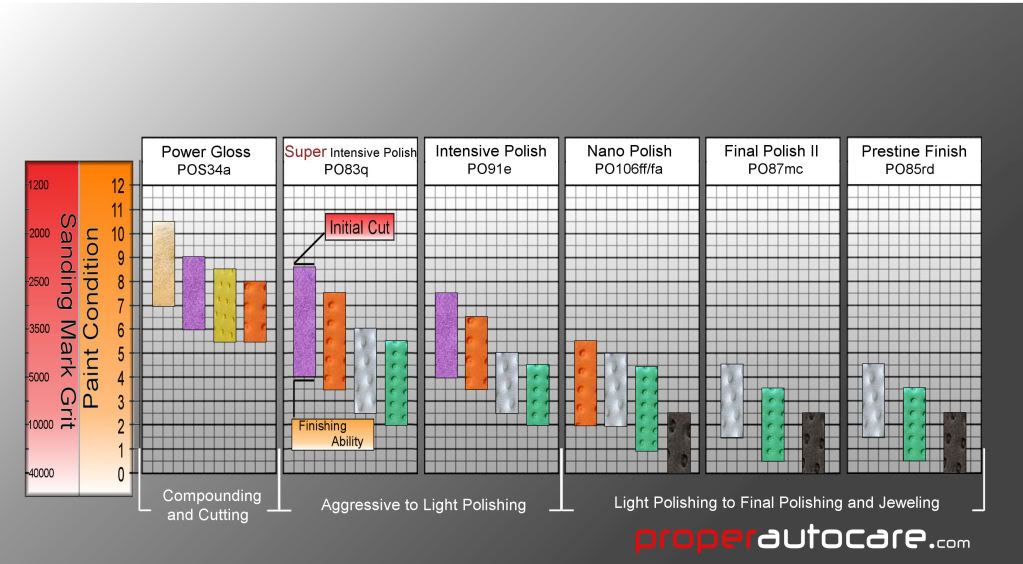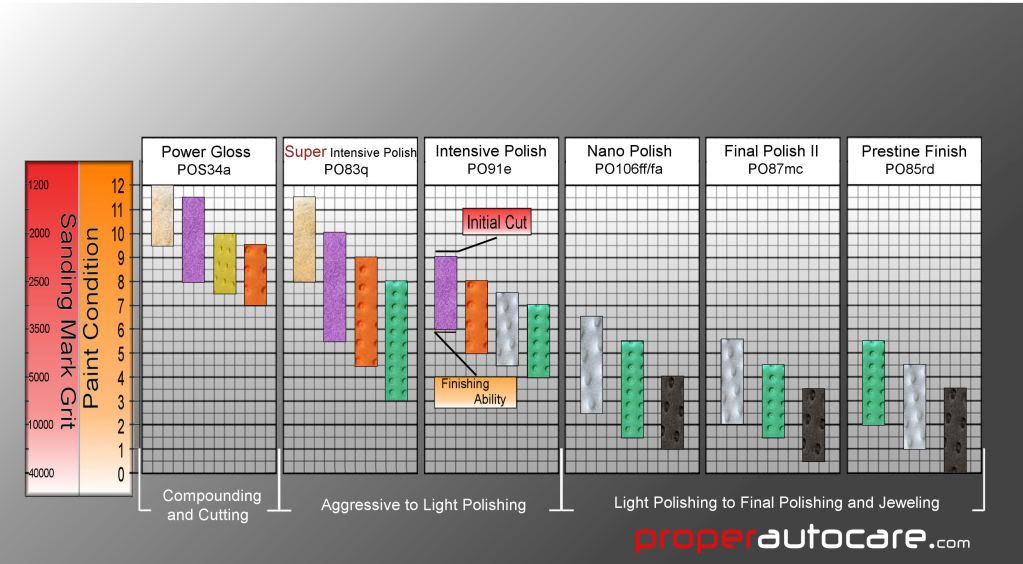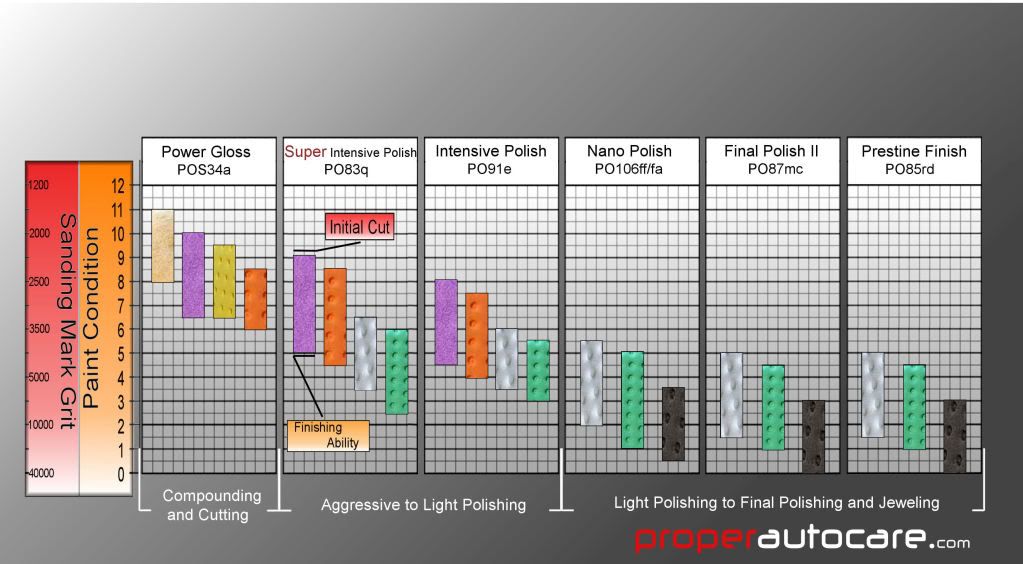We created these charts as a guideline to help better understand the Menzerna polish line. Menzerna originally formulates their polishes to be used at the OEM level, which means that these polishes are used on an assembly line to remove paint defects at the factory on fresh paint. Often these polishes are applied with extremely high speed pneumatic Random Orbital Polishers. Many times the polishes are tweaked to meet specific factory requirements based on the exact paint system, assembly line speed, and geographical location/ environmental conditions..
In 2002 Proper Auto Care sought to bring Menzerna to the US enthusiast market. At this time Menzerna`s United States distributor was focusing on the OEM market. Proper Auto Care struck a licensing agreement with Menzerna of Germany to import the polishes and expand the product line. All of Menzerna`s OEM polishes where diligently tested. The best products for the end user market: Pos34a (Power Gloss),PO91e (Intensive Polish) and PO85u (Final Polish), and PO115c (Finishing Touch Glaze) where carefully chosen to launch the line. These products, still viable today, where the most consistent preforming Menzerna polishes at the time. Proper Auto Care replaced Final Polish with PO87mc Micropolish which was appropriately renamed Final Polish II. They continue to work on all paint systems including lacquer, enamel, high solid, water based, single stage, and nano technology paints.
No one in the United States has sold Menzerna polishes to the enthusiast and end-user market longer then Proper Auto Care. It is our belief that no one has invested as much time or has as much experience in fully understanding the Menzerna product line-up. Because these polishes where OEM designed for OEM market, they can exhibit some unique characteristics in their application when used in the dynamic environments that detailers and enthusiasts face. The tools that enthusiasts and detailers commonly use, including Random Orbital, Dual-Action, and Rotary Polishers are far different the the tools used at the OEM level.
With the large number of Menzerna polishes available today there is a fair amount of overlap in each polishes function tweaked to the requirements that polish was designed to meet. Given the factors given in the preceding paragraphs, along with the infinitive variable of the polishers technique, it is impossible to create concrete charts that will be 100% accurate 100% of the time. Rather we choose to create the most in depth charts that can be used as a general guildine to help our customers better understand the wide variety of quality Menzerna Polishes offered by Proper Auto Care.
Understanding the Charts:
Polishing Range- Menzerna Polishes utilize diminishing abrasives which have greater cutting power at the beginning of the polishing cycle. As these abrasives are worked over the paint they fracture, or reduce in size and sharpness, becoming finer. This `break down` of the abrasives is what allows the polish to remove defects initially, and then as they become finer, polish the surface to a high gloss. Many factors effect the range the polish has, the most important two being the paint itself and the pad it is applied with. These charts are coded to specific Lake Country polishing pads, they show the initial cut of the polish and the types of defects that can be removed from typical paint systems, to the typical level the polish will finish at, or what types of defects will remain when the polish is fully exhausted and the abrasives have spent.
There are so many factors involved in paint polishing and so many factors that enthusiasts and detailers face that are different then the OEM level that these charts serve as a general, but thorough guideline.
Paint Condition/ Grit Level- The goal of polishing paint is to make it as microscopically smooth or level a possible. The smoother the paint is, the more gloss it has as light is evenly reflected away. Uneven, damaged, or scratched paint acts to refract or scatter light which causes a loss of potential gloss. On our scale, the higher the number, the more damaged or uneven the paint is, requiring more aggressive polishes and pads to smooth it out efficiently. Paint that is in very poor condition, scale 12-10, is very uneven and heavily damaged. The defects range in depth that would be seen if a piece of 1200-2000grit was rubbed into the surface.
Paint that is in a condition between 9-6 would have fairly moderate damage that would equal the depth caused by roughly 2200 to 3500 grit particles being rubbed against the paint`s surface. Road grime that is heavy wiped into the surface or dirty brushes at a drive through car wash would typically cause this type of marring. These would constitute typical deep swirl marks.
Paint that is in condition between 5-2 would have moderate to light defects, such as wash induced marring or dust damage. The depths of defects would range from 4000 grit to a hypothetical 10,000 grit and should require very light polishing techniques to remove. Paint that is level two may appear perfect or near perfect and have excellent gloss. It is very possible to have paint in the range of 2 to 3 that will have no visible (macroscopic) defects.
Paint ranges below 2 deal with hypothetical grit numbers for comparison and for the most part microscopic defects that rob the slightest amount of gloss from the paint. The grit numbers range from 10,000 to 40,000 grit. Paint can never be truly perfect, at the microscopic level there slight differences in height. The grit numbers are solely to illustrate that even when paint looks perfect it can be refined finer and finer in order to achieve slight levels of gloss improvement. Wiping a fresh, plush, clean microfiber towel against clean paint will at some level impart some slight amount of scratching on the paint`s surface at the microscopic level. To the naked eye we will see no loss of gloss, but science tells us that it does exist. We estimated this type of near impossible to detect super microscopic marring at 40,000 grit for reference.
Hard Paint Polishing Chart

Meduim Paint Polishing Chart
Soft Paint Polishing Chart

Results 1 to 15 of 56
Threaded View
-
04-14-2009, 11:14 PM #1
Understanding Menzerna: Proper Auto Care`s guide to Menzerna!
Thread Information
Users Browsing this Thread
There are currently 1 users browsing this thread. (0 members and 1 guests)
Similar Threads
-
Proper Auto Care Guide: Meguiars M105 and M205 Polish/Pad Application
By Todd@RUPES in forum Auto Detailing 101Replies: 12Last Post: 11-17-2010, 09:36 AM -
Proper Auto Care: Understanding Lake Country Polishing Pads
By Todd@RUPES in forum Machine Polishing & SandingReplies: 29Last Post: 06-05-2010, 12:39 PM -
Understanding Menzerna
By snowskate in forum Car Detailing Product DiscussionReplies: 67Last Post: 12-03-2007, 01:21 AM -
Menzerna from Autogeek & Proper Auto Care
By jgatuslao in forum Car Detailing Product DiscussionReplies: 69Last Post: 11-28-2007, 09:01 AM -
Menzerna Pad Guide
By imported_Devilsown in forum Car DetailingReplies: 4Last Post: 02-02-2007, 06:38 PM








 Reply With Quote
Reply With Quote
Bookmarks